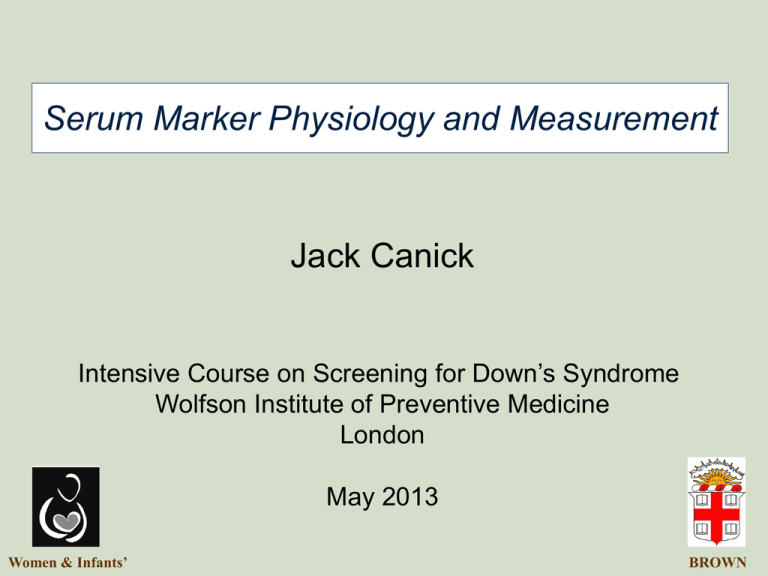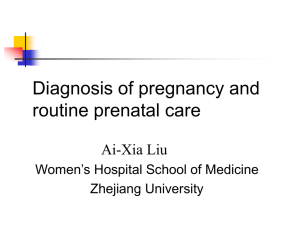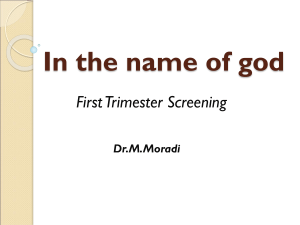Wolfson Institute 2013: Serum Marker Physiology and Measurement
advertisement

Serum Marker Physiology and Measurement Jack Canick Intensive Course on Screening for Down’s Syndrome Wolfson Institute of Preventive Medicine London May 2013 Women & Infants’ BROWN What is the basis of maternal serum screening for Down syndrome? In Down syndrome pregnancy, certain substances, synthesized and secreted by the fetoplacental unit, are abnormal when measured in maternal serum. Prenatal markers of the Down syndrome phenotype: so-called “Surrogate Markers” Fetal ultrasound: Maternal Serum: PAPP-A low Nuchal Translucency increased AFP low Nasal Bone absent/small uE3 low Nuchal fold thickness larger shorter b-hCG elevated Femur/Humerus inhibin A elevated Echogenic cardiac focus present Ductus venosus doppler reversed a-wave Nuchal Translucency Nasal Bone Ductus venosus doppler www.fetalmedicine.com/fmf What are these substances? • All but one are glycoproteins. • A glycoprotein is a protein with chains of carbohydrates attached (usually adding 10-40% to the molecular weight). • Proteins that have carbohydrate chains added to them are almost always targeted for secretion out of the cell into the vascular system. • Glycoproteins are usually more soluble and have longer halflives than proteins (they remain in the vascular system for a longer time). Example of a gylcoprotein: hCG In: Blithe DL et al, Trends Endocrinol 1:394-8, 1990 The seventh marker (uE3) is a steroid hormone. • Steroid hormones are made from cholesterol, the major steroid of the body. • Steroids are lipid-like, fused ring structures made up entirely of carbon and hydrogen, with a small number of oxygen groups attached. • Steroid hormones are secreted by diffusion from their sites of synthesis, and can pass in and out of all cells in the body. Relative size of a steroid and protein: Testosterone bound to the human androgen receptor en.wikipedia.org/wiki/Anabolic_steroid Molecular weights of the markers Mol Wt (kDa) relative radius of sphere uE3 0.3 1.0 inhibin-A 30 4.7 hCG 40 5.2 AFP 70 6.1 PAPP-A 700 13.2 marker PAPP-A AFP (70K) uE3 (0.3K) inhibinA (30K) hCG (40K) (700K) If PAPP-A is the world’s land mass, uE3 is Great Britain. alpha-fetoprotein (AFP) • a glycoprotein • structurally and functionally similar to albumin • antigenically distinct from albumin • an ‘oncofetal antigen’ • produced by the yolk sac and fetal liver • the most abundant protein in fetal circulation • half-life in blood approx. 7 days Aside: Why are maternal serum AFP levels elevated in open fetal defects? Simple biological explanation: A strong concentration gradient Fetal circulation Amniotic fluid Maternal serum open defect AFP concentrations in the fluid compartments of pregnancy. Seppala M. (1975) Ann NY Acad Sci 259:59. alpha-fetoprotein (AFP) Role in pregnancy: • Does not appear to be required for normal fetal function or development. • Examples of absent AFP and normal obstetrical outcome. [Greenberg F et al, Am J Obstet Gynecol 1992;167:509-11; Sharony R et al, Eur J Hum Genet 2004;12:871-4] • AFP, like albumin, can bind fatty acids, and other hydrophobic chemicals. unconjugated estriol (uE3) • a steroid hormone • the major estrogen of pregnancy • requires the fetal adrenal, fetal liver and placenta for its synthesis • Turns over very rapidly in blood (t½ approx. 20-30 min.) • Es-triol = 3 hydroxy groups • Called ‘unconjugated’ because it is the free or nascent form, as it is secreted by the placenta. MOTHER Cholesterol (LDL) PLACENTA FETUS Progesterone Cholesterol (LDL) ADRENAL uE3 secretion Cholesterol (LDL) uE3 DHEA sulfate Conjugation to E-sulfates and E-glucuronides followed by excretion LIVER DHEA sulfate 16a-OHDHEAS 16a-OHDHEAS estriol (uE3) Role in pregnancy: • Weak estrogen. • Softening of the cervix prior to parturition? • Contributes to preparation of breast for lactation? human chorionic gonadotropin (hCG) • alpha-beta subunit glycoprotein hormone • molecular weight approx. 38,000 daltons • synthesized in placenta syncytiotrophoblast • half-life in blood approx. 1-2 days free alpha and beta subunits of hCG • no known biological function as individual subunits beta alpha • molecular weight of alpha subunit approx. 15,000 daltons • molecular weight of beta subunit approx. 23,000 daltons • secreted by placenta as free subunits; produced by dissociation of intact hCG in blood Pattern of hCG and its Free Subunits in Maternal Serum During the First Half of Pregnancy M Ozturk et al, Endocrinology 1987; 120:549-558. During 1st trimester, is required for maintaining progesterone synthesis by the mother’s corpus hCG luteum. progesterone hCG: Role in Pregnancy When a male fetus is present, stimulates the fetal testes to make testosterone, required for male phenotypic development. testosterone alpha inhibin A inhibin A beta A beta B inhibin B • alpha-beta subunit glycoprotein hormone • inhibin-A = alpha subunit + betaA subunit • member of the TGFb gene family (also includes inhibin B, activins, anti-Mullerian hormone) • molecular weight approx. 32,000 daltons • Inhibins are synthesized in ovary (inhA and B), testis (inhB only), and placenta inhibin A (inhA) Role in pregnancy: • Inhibits FSH secretion at the level of the pituitary, which contributes to preventing ovulation during pregnancy. Inhibin A Placenta PAPP-A: pregnancy-associated plasma protein-A • very high mol. wt. glycoprotein (approx. 700,000 Da) • made up of 4 subunits: 2 PAPP-A subunits (approx. 250,000 Da each) 2 pro-MBP subunits (approx. 50-90 Da each) • serum levels increase throughout pregnancy PAPP-A S S Pro-MBP S S Pro-MBP S S PAPP-A PAPP-A: pregnancy-associated plasma protein-A • pro-MBP is the inactive precursor of Major Basic Protein (MBP). • MBP is found in the eosinophil crystalloid body; it has a very basic pI; it is cytotoxic; it functions in inflammatory response. • PAPP-A itself is an insulin-like growth factor binding protein-4 (IGFBP-4) protease. • It may facilitate IGF action at the maternal-placental interface (Sun et al, J Clin Endocrinol Metab 2002;87:5235). In other words, it may be involved in regulation of fetoplacental growth. the www.nature.com/labinvest/journal/v89/n7/ PAPP-A is an IGFBP protease: IGFBP proteases release circulating IGF to interact with its receptors on target cells and stimulate growth IGF target cell GROWTH Median Levels of Serum Markers during the Screening Period in Unaffected Pregnancies AFP 15 hCG or free b-hCG uE3 20 15 GA (wks) 10 20 GA (wks) GA (wks) inhA 15 PAPP-A 20 GA (wks) 10 14 GA (wks) 20 Measurement of Serum Markers • All current analytes are measured by immunoassay. • Requires specific antibodies used as tools to pull out a particular analyte (the antigen). • If a large molecule (i.e., a protein) is to be measured, it is most common to use a two-site immunometric assay. • If a small molecule (i.e., a steroid) is to be measured, it is most common to use a single-site competitive immunoassay. • In either case, the signaling method can be radioactive, colorimetric, fluorometric, chemiluminescent (or others). Two-Site Immunometric Assay (for large molecules) Y Y Antibody 1 (capture Ab) Protein X Antibody 2 (signal Ab) Y Y Y Y this is measured Non-competitive Immunometric 2-site assay: AFP Standard Curve 100000 Fluorescence 10000 1000 36 ng/ml 100 10 1 0 1 5 20 AFP concentration (ng/ml) 100 500 Competitive Immunoassay (for small molecules) Y antigen Steroid X limited amount of antibody (capture Ab) Y Y + signal antigen (signal Ab) this is measured Competitive immunoassay: 0.8 1.0 Standard Curve B/ B0 0.1 0.2 0.4 0.6 3.6 ng/ml 0.1 1 uE3 (ng/ml) 10 100 Measurement of Serum Markers: Issues • Most clinical laboratories use commercial assays. • For AFP, uE3, hCG, free b-hCG, and PAPP-A, there are choices in selecting a commercial assay. • For inhibin A, only one manufacturer, Beckman Coulter, offers the assay, in both manual and automated formats. The antibody pair is the same for both, but the sample treatment is different. Both have been validated to work in serum screening. • In prenatal screening, the accuracy of the individual assay is less important than the precision, since analyte values are normalized to a common unit, the multiple of the median (MoM). Physiology and Measurement of the Serum Screening Markers Coming Soon: Physiology and Measurement of Plasma DNA As you can see from the model, the structure is basically a …long, …twisty, …uh, ropeladdery-type…thingy. The Biology of DNA









